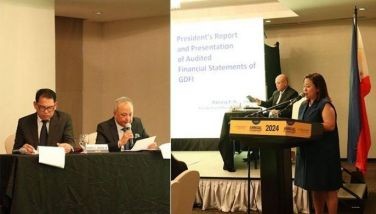Why reclamation of nearshore Manila Bay is a very bad idea
Mounting concern about the accelerating moves toward reclaiming various portions of nearshore Manila Bay motivates this commentary.
Much of the opposition to reclamation has centered on how it would block our views of the Bay’s beautiful sunsets; the destruction of shallow-marine ecological habitats; and how reclamations would enhance flooding in the areas behind them. These are all valid concerns. But they may be far outweighed by the hazards that reclamation would generate.
There are three geological reasons why this reclamation is a very bad idea that poses lethal risks to many people.
Land subsidence
First, even without reclamation, continuing rapid and accelerating subsidence of the coastal lands bordering the bay is worsening both floods and high-tide invasions. Philippine authorities now generally accept that global warming is raising sea level by about 3 millimeters per year, and worry about how this rise must be aggravating Metro Manila flooding. But that is only about 1 1/4 inch every 10 years! The land is subsiding about 30 times faster, mainly from over-pumping of groundwater. Reclamation may well speed up the sinking of the land, from withdrawal of groundwater, or from the added weight of new buildings, or both.
Academician Fernando Siringan of UP Diliman’s Marine Science Institute and his colleagues have documented that Metro Manila’s coastal areas are sinking as fast as 9 centimeters (3 1/2 inches) every year.
And Dr. Mahar Lagmay’s Volcano-Tectonics Laboratory at UP Diliman’s National Institute of Geological Sciences has used sophisticated, precise satellite data to verify subsidence over wide areas of Metro Manila, with the proposed reclamation areas experiencing up to 5 centimeters (2 inches) per year.
The Department of Public Works and Highways has ignored or minimized the problem of land subsidence in planning their expensive but ineffective Kamanava flood-control projects. It would not be surprising if reclamation planners also ignore subsidence in order to minimize costs and maximize profits, but thereby enhancing the risks.
Storm surges and waves
The second geologic threat to reclaimed areas is the combination of surges and storm waves driven against our coasts by passing typhoons. Powerful, but still poorly recognized and understood hazards, storm surges are increasing in strength and frequency as our climate changes.
The Philippine Atmospheric, Geophysical and Astronomical Services Administration (PAGASA) reports indicate that the coastal areas targeted for reclamation experience typhoon surges up to 4 meters high. Depending on how long the typhoon winds last, and the timing and heights of the normal tides, a storm surge and the flooding it causes can last from hours to days.
The havoc that storm surges wreak is magnified by huge waves that ride atop the surge, battering the coast. Videos of Typhoon Pedring’s storm surge and gigantic waves pounding Roxas Boulevard into rubble on Sept. 27, 2011 are very instructive. These are available on the Internet at https://www.youtube.com/watch?v=KVqOVR9lytk and https://www.youtube.com/watch?v=UlhncBQE8-A.
Viewers aren’t really watching storm surges in motion; after all, a single surge takes hours and even days to pass. During the short periods of the footages, the surge has already raised the water level, which doesn’t change while we watch. What excites our awe are the gigantic storm waves, lifted by the surge, following each other every several seconds, smashing against the breakwater and sending huge plumes up higher than the tallest coconut trees along the boulevard.
Storm waves are one of Nature’s most destructive forces. No one has said it better than Captain D. D. Gaillard of the US Army Corps of Engineers, writing in 1904:
“No other force of equal intensity so severely tries every part of the structure against which is exerted, and so unerringly each weak place or faulty detail of construction.
“The reason for this is found in the diversity of ways in which the wave may be exerted or transmitted; for example: (1) The force may be a static pressure due to the head of a column of water; or (2) it may result from the kinetic effect of rapidly moving particles of the fluid; or (3) from the impact of a body floating upon the surface of the water and hurled by the wave against the structure; or (4) the rapid subsidence of the mass of water thrown against a structure may produce a partial vacuum, causing sudden pressures to be exerted from within.
“These effects may be transmitted through joints or cracks in the structure itself; (a) by hydraulic pressure, or (b) by pneumatic pressure, or by a combination of the two; or (c) the shock produced by the impact of the waves may be transmitted as vibrations through the materials of which the structure is composed…â€
It is shocking that major reclamation is even being considered, because we do not even have sufficient wave data with which to design shoreline structures! The US Navy, with its fleets worth many billions of dollars at stake, is the organization most dedicated to studying the wave regime of Manila Bay, with the purpose of using it as a haven during typhoons. Its Naval Research Laboratory reported in 2012 that “Quantitative information on wave height data for Manila Harbor or Manila Bay is not readily available.†It then reported that winds from the north-northwest funneled through the Central Valley can generate 10-foot waves, and that a US Navy evaluation team reported waves 3-5 meters (10-16.5 ft) high in Manila Bay in February 2012. This was most likely related to an unnamed tropical depression that lasted from Feb. 17 to 20, with maximum winds of only 55 kilometers per hour.
Standard wave-forecasting techniques employing Sverdrup-Munk-Bretschneider nomograms inform us that 200 kilometer-per-hour (Category 3) typhoon winds blowing for only three hours across the bay from the southwest would propel waves more than 5 meters or about 18 feet high to the bayshore. Little surprise, then, that storm surges and waves lifted large ocean-going freighters and parked them on Roxas Boulevard during Typhoon Patsy in 1970 and Typhoon Ora in 1972.
Liquefaction during earthquakes
But by far the greatest hazard that threatens coastal areas, whether underlain by natural deposits like those of the Pasig River delta or artificial reclamations, is seismically induced liquefaction. This is true for California’s Bay area as well as Manila Bay.
All bayfill materials, natural or man-made, are masses made up of pieces of rock ranging in size from tiny particles of clay to large boulders. Spaces between the solid pieces are occupied by water. Under normal conditions, the solid particles are in contact, so that the lower ones bear the weight of other grains above them as well as any buildings on top of them.
But during the minute or so that an earthquake lasts, the shaking breaks the contact between grains. Together, the solids and water behave as a “slurry,†or liquid without strength. During that minute, buildings sink into it or topple.
Reclaimed areas in Manila Bay would not require an earthquake to occur nearby to suffer serious damage. In 1968, Manila was hard-hit by a magnitude 7.3 earthquake in Casiguran, Quezon, 225 kilometers away. Many structures that were built on river deposits near the mouth of the Pasig River were destroyed. The six-story Ruby Tower in Binondo collapsed, killing 260 people.
We also must be mindful of the lessons taught by the great Nueva Ecija earthquake of 1990, which devastated Baguio, 100 kilometers away. The coastal city of Dagupan, also 100 kilometers away, suffered widespread liquefaction, which caused many buildings to topple, sink into the ground, or become tilted and unusable.
This is not to say that Manila is immune from nearby earthquakes. Earthquakes are much stronger the closer they are. In other words, if the distance is cut in half, the shaking is four times stronger.
Have the proponents of reclamation not considered the 2004 earthquake impact study for Metro Manila conducted by the Japan International Cooperation Agency, the Metropolitan Manila Development Authority, and the Philippine Institute of Volcanology and Seismology? The main conclusion of that study is that Metro Manila is overdue to experience a catastrophic magnitude 7.2 earthquake. Furthermore, in all its possible earthquake scenarios, the coastal areas would suffer most, because of liquefaction.
Our history of ignoring science while building projects fail
In the 1980s, poorly designed lahar dikes were being built at Mayon Volcano despite the scientific objections I raised to them. Those dikes continued to be built until Supertyphoon Reming destroyed them all in 2006, killing 1,266 people who had sought safety by living behind them.
During the 1990s, lahar-dike builders repeated the same mistakes on a much larger scale at Pinatubo Volcano. Again, informed scientists including myself objected to no avail. In October 1995, lahars generated by Tropical Storm Mameng breached badly constructed dikes and totally destroyed Barangay Cabalantian in Bacolor, Pampanga, killing hundreds of people.
During the 2000s, the Department of Public Works and Highways built numerous costly but ineffective flood-control structures in Central Luzon and Metro Manila’s Camanava district. No objections raised by academician Siringan and me made any difference. Year after year, they fail, and more money is spent on cosmetic repairs.
In 2008, a legislative initiative was launched to activate the Bataan Nuclear Power Plant. None of the available, detailed geology of Bataan and its offshore surroundings made a difference to the planners. Only the catastrophic Japanese earthquake and tsunami that devastated Fukushima halted that effort. But that project is still being pushed by wealthy but scientifically uneducated proponents. It is said that “a little knowledge is a dangerous thing.†I add: “A little knowledge coupled with a lot of money is a VERY dangerous thing.â€
Today, it seems that science is again being blithely ignored by the financial interests and government authorities promoting the various reclamation projects. Will we never learn?
* * *
Kelvin S. Rodolfo, Ph.D., is a professor emeritus at the Department of Earth and Environmental Sciences, University of Illinois at Chicago. He is a corresponding member of the Philippine National Academy of Science and Technology. He lives in Viroqua, Wisconsin and comes to the Philippines regularly. E-mail him at [email protected].
- Latest























